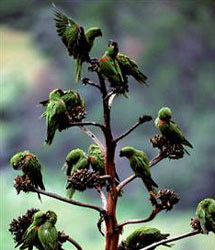 |
 |
 |
 Editorials | Environmental | February 2005 Editorials | Environmental | February 2005  
Nine New Environmental 'Hot Spots' Listed
 Reuters Reuters

Global list of regions to protect grows to 34.


Maroonfronted parrots like these are considered a "vulnerable" species and are native to the Madrean Pine-Oak Woodlands in the United States and Mexico - one of the new hotspots identified by scientists. This flock was photographed in the El Taray Sanctuary in Mexico's Sierra Madre mountains. (Photo: Patricio Robles Gil / Sierra Madre) |
A global study has identified nine new environmental "hot spots," areas of great ecological diversity that are under threat and together shelter most of the planet's endangered plant and animal species.

"Nine new hot spots have been identified, including one that traverses the U.S.-Mexico border, one in southern Africa, and one that encompasses the entire nation of Japan," said Conservation International, which helped organize the analysis in a book "Hotspots Revisited" that was released Monday.

The findings bring to 34 the number of hot spots identified by leading scientists.

They are home to 75 percent of the world's most threatened mammals, birds, and amphibians, which survive in fragile habitats covering just 2.3 percent of the Earth's surface.

These areas once covered almost 16 percent of the planet, an area the size of Russia and Australia combined, underscoring the threats posed by human encroachment and habitat destruction.

Nearly 400 scientists and other experts contributed to the four-year study.

Two key factors are used to designate a hot spot: a high concentration of endemic species - which means they are found nowhere else - and a serious degree of threat.

Earth's 'Emergency Rooms'

The Madagascar and the Indian Ocean Islands hot spot has 24 plant and vertebrate families found nowhere else on Earth.

Some of the hot spots have less than 10 percent of their original habitat left - which means they probably once contained many unidentified species that have been lost forever.

"The biodiversity hot spots are the environmental emergency rooms of our planet ... We must now act decisively to avoid losing these irreplaceable storehouses of Earth's life forms," said Russell Mittermeier, president of Conservation International.

"We now know that by concentrating on the hot spots, we are not only protecting species, but deep lineages of evolutionary history. These areas capture the uniqueness of life on Earth," Mittermeier said.

Tropical Trend

Most of the hot spots are in tropical or sub-tropical areas, highlighting the diversity of life found near the equator, where yearround warmth and good rainfalls enable many plants and animals to thrive.

But many are also found in very poor countries or regions, which magnifies the threat as impoverished and swelling rural populations encroach on remaining habitat.

The new hot spots that have been added are:

• The East Melanesian islands, which have degraded dramatically over the last five years;
• The Madrean Pine-Oak Woodlands on the U.S.-Mexico border;
• Japan;
• The Horn of Africa;
• The Irano-Anatolian region in Iran and Turkey;
• The mountains of central Asia;
• The Himalaya region;
• Eastern Afromontane, which stretches along the eastern edge of Africa from Saudi Arabia to Zimbabwe.
• Maputaland-Pondoland-Albany in southern Africa, which includes parts of Mozambique, South Africa and Swaziland; | 
 | |
 |



